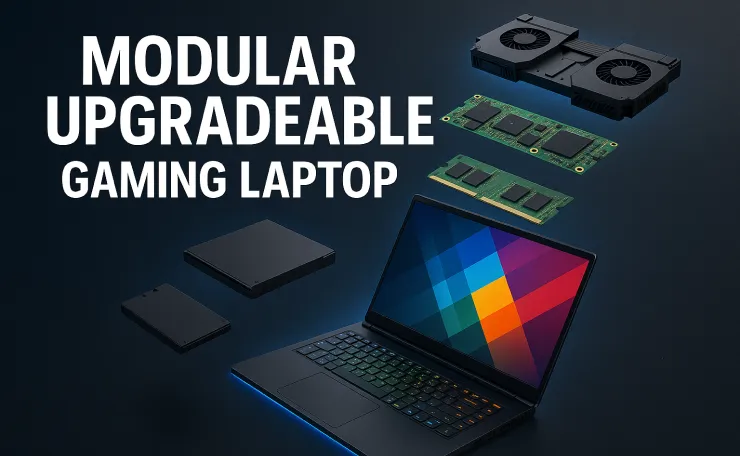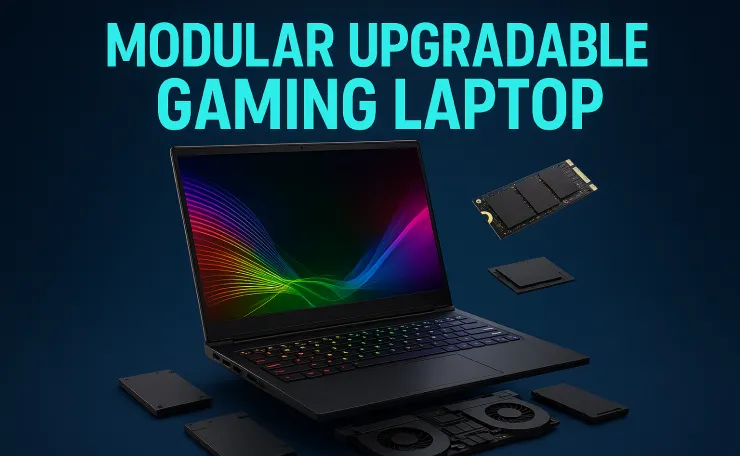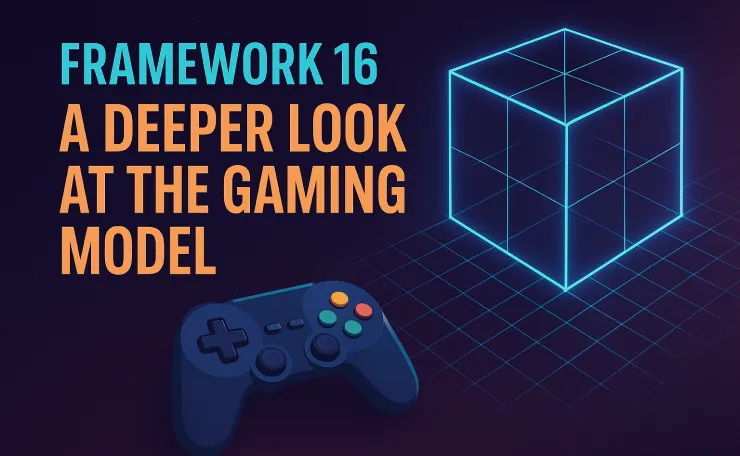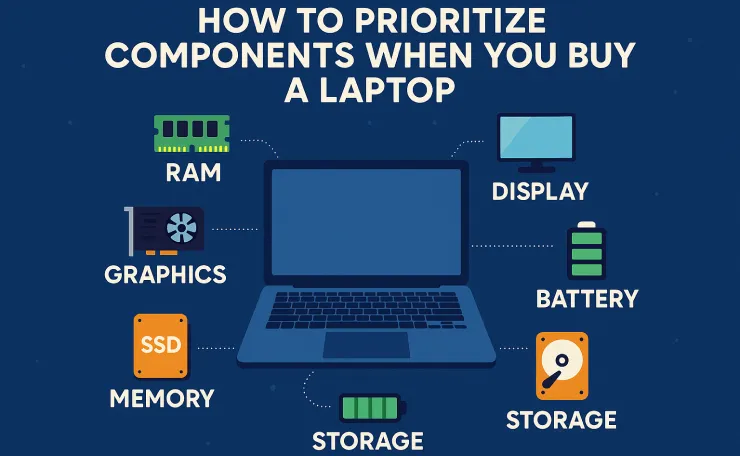
Purchasing a high-quality Windows laptop is a significant investment. If you want longevity without lock-in, a Modular upgradable gaming laptop is a smart way to extend usable life—refresh individual parts instead of replacing the whole machine.
For years, upgradeability has been shrinking. What used to be standard—replaceable RAM and storage, sometimes even a CPU or GPU—has largely given way to soldered memory, hidden SSDs, and fully sealed designs. In most 2025 notebooks, the RAM is fixed, the drive is hard to reach, and the processor and graphics are off-limits.
Why choose a Modular upgradable gaming laptop

A modular approach reverses that trend. Rather than treating your notebook as disposable, treat it like a platform that evolves. You can scale memory for heavier games, slot in a faster SSD when your library grows, replace an aging mainboard with a new CPU generation, or even attach a discrete graphics module when you want more frames.
Beyond performance, there’s cost and sustainability. Incremental upgrades spread spending across years and help reduce e-waste. And because you control your ports, keyboards, displays, and more, you configure the machine for your workflow instead of adapting to someone else’s fixed bill of materials.
- [Game-Ready Storage & Memory: No More Load Screens] Experience unparalleled performance with 32GB DDR5 RAM and a 1TB PCI…
- [Unstoppable Power: Blazing-Fast Speed & Graphics] Core i7-14650HX (16 Cores, 24 Threads, 30MB L3 Cache, 1.60GHz base fr…
- [Immersive 240Hz Display: See Every Move with Precision] 16″ WQXGA (2560 x 1600) Ultra-Crisp Display, 240Hz ultra-high r…
- [Lag-Free Connectivity: Stay Ahead of the Competition] 3 x Superspeed USB Type-A, 1 x Superspeed USB Type-C, 1 x HDMI, 1…
- Copilot+ PCs. A New AI Era Begins Turn your ideas from text prompts into generated artwork. With Recall1, search across …
- Stunning 16-inch Glossy OLED Touch Display Indulge in stunning visuals in breathtaking 2880 x 1800 resolution (16:10) an…
- Supercharged Intel Core Ultra 7 (Series 2) Processor Unmatched performance featuring an Intel Core Ultra 7 256V processo…
- Powerful Intel Arc Graphics Discrete-class graphics engineered for the Vivobook 16 Flip. Create and play with superior p…
- High-performance AMD Ryzen 5 7430U processor (6 cores, 12 threads), with a base clock of 2.3GHz and a turbo frequency of…
- Fast Response & Large Storage:16GB DDR4 RAM ensures rapid command processing, while a 1TB NVMe SSD (512GB/1TB optional) …
- Realistic Visual Enjoyment:The 15.6-inch FHD IPS screen (1920×1080 resolution, 16:9 aspect ratio) features 5mm narrow be…
- Large Capacity Battery & Fast Charging:The 62.7Wh (5500mAh) battery provides up to 8 hours of on-the-go use, eliminating…
- 【2-Year Manufacturer’s Warranty, Partially Assembled in the USA, 90-Day Hassle-Free Returns】Your satisfaction is our pri…
- 【Outstanding AMD Ryzen 7 6800H CPU】The NIMO Laptop features the AMD Ryzen 7 6800H CPU, a powerhouse with 8 cores and 16 …
- 【Type-C 100W PD Fast Charger】Our NIMO laptop comes with a 6.56ft USB-C to USB-C fast charging cable and a Type-C 100W PD…
- 【Durable Configuration】Our NIMO laptop features dual-channel memory and supports detachable RAM and SSD, allowing you to…
- 【Memory & Storage】16GB high-bandwidth DDR5 RAM to smoothly run multiple applications and browser tabs all at once; 512GB…
- 【AMD Processor】AMD Ryzen 5 7535HS ( 3.3 GHz base clock, up to 4.55 GHz max boost clock, 16 MB cache, 6 cores, 12 threads…
- 【Display】15.6″ diagonal, FHD (1920 x 1080) 144Hz Anti-Glare, 1080p Full High Definition resolution for smooth, crisp gam…
- 【Tech Specs】2 x SuperSpeed USB Type-A , 1 x SuperSpeed USB Type-C, 1 x HDMI 2.1, 1 x RJ-45, 1 x headphone/microphone com…
Framework as the case study for real modularity
Among current options, Framework stands out with a design built for user serviceability from the ground up. Its laptop lineup includes 13-inch and 16-inch models (with a 12-inch concept in the wings), and you can choose modern Intel or AMD platforms. What distinguishes Framework is not just swappable RAM and storage but a replaceable mainboard, modular port system, easily accessible battery, and even cosmetic parts like bezels and keyboards.
Customization begins at the edges: instead of living on a dock, you slot tiny expansion cards that carry the ports you actually need—USB-C or USB-A, HDMI or DisplayPort, microSD, Ethernet, even storage. Inside, you pick CPU, DDR5 memory, NVMe storage, Wi-Fi adapter, and operating system. When the CPU generation ages out, you drop in a newer mainboard and keep working in the same chassis.
Framework backs the concept with a parts marketplace that sells virtually everything inside the machine. That marketplace is the practical difference between a promise and a plan—you can buy a replacement display, keyboard, battery, fans, speakers, and more at transparent prices instead of hunting third-party sellers or junking the whole computer.
Discover how offline AI power is transforming creativity with Stable Diffusion. Check out the best laptops for running Stable Diffusion offline and boost your workflow.
Framework 16: a deeper look at the gaming model

Gaming puts unique stress on thermals, power delivery, and longevity. Framework’s 16-inch model addresses that with a clever discrete-GPU module that attaches to the rear of the chassis. The footprint grows slightly from the back, but the body stays thin (around 0.7in for the 16-inch model, ~0.62in for the 13-inch), keeping a modern profile while making room for cooling and GPU power. If you’re targeting a Modular upgradable gaming laptop that stays portable, this configuration shows how the pieces fit together.
Here’s an example configuration that captures the spirit of the platform:
- CPU: AMD Ryzen 9 7940HS
- Memory: 32GB DDR5-5600
- Integrated GPU: AMD 780M
- Discrete GPU: AMD Radeon RX 7700S
- Display: 16-inch, 2560×1600, 165Hz
- Battery: 85Wh
- Storage: 1TB NVMe (e.g., WD SN810)
- Price at review: £2,538 | $2,538
The RX 7700S module turns the machine into a proper gaming notebook without making it brick-thick. The long-term test for the concept, of course, is whether next-gen modules arrive that you can drop in later. Unlike past approaches such as MXM cards or one-off promises (remember the Alienware Area-51m saga?), Framework has designed both the chassis and an ecosystem to support future parts rather than treating modularity as a marketing checkbox.
Lessons from past “upgradeable” laptop GPUs
For context, mobile GPU upgradeability has a checkered history. MXM—the Mobile PCI Express Module—was intended as a standard socket so laptop makers could offer new GPUs in older chassis. In practice, thermal envelopes, power delivery, board layouts, and vendor lock-ins meant upgrades were rare, expensive, or limited to a small set of officially supported combinations. Some gaming brands teased multi-generation upgrade paths but delivered only the launch-day options. That left enthusiasts with a premium system and no realistic way to step up the graphics a year later.
The takeaway: genuine modularity requires a system architected for replacement from day one, plus a sustained supply of compatible parts and documentation. That’s what separates a hobbyist experiment from a platform.
Experience next-level graphics on a budget. Check out the top gaming laptops under $800 with ray tracing in 2025.
How to prioritize components when you buy

Budget is always the hard constraint. The goal is to put your money where it most affects frame rates and experience while keeping headroom for the upgrades you’ll likely want later. Here’s how to think about each component when choosing a gaming notebook today.
1) Graphics (GPU)
In gaming, the GPU dictates frame rates, visual fidelity, and how long your settings stay near “High/Ultra.” The top tier will always be expensive; the smarter question is which tier meets your target resolution and refresh rate. If you play competitive shooters at 1080p-to-1440p on a 165Hz panel, you might prioritize a mid-upper GPU class that comfortably clears 120fps in your favorite titles with adaptive sync engaged.
For reference, GPU series naming climbs by model number within each generation (e.g., a GeForce RTX 4080 is faster than a 4070). Generational updates typically improve performance-per-watt and features (ray tracing, frame generation). You’ll increasingly see new mobile GPUs arrive alongside architectures designed for efficiency. Whether you choose AMD or Nvidia, match the GPU to your monitor: there’s no sense paying for frames you can’t display.
2) Processor (CPU)
Modern 8-core (or better) mobile CPUs from AMD and Intel are excellent for gaming and creator workloads. Clock speed boosts your minimum fps in CPU-bound games and helps with streaming, encoding, or asset compilation. You don’t need a halo chip, but avoid dated silicon if you plan to keep the laptop for several years; a newer CPU platform also means newer I/O, media engines, and better integrated graphics for efficiency on battery.
3) Memory (RAM)
Treat 16GB of DDR5 as the floor for a midrange gaming machine; 32GB is ideal if you multitask (Discord, browsers, mods, recording) or dabble in creation apps. Importantly, check whether the memory is a socketed SO-DIMM rather than a soldered LPDDR. Socketed RAM lets you start at 16GB and go to 32GB or 64GB later without rebuying the laptop.
4) Display
Screen size and refresh dictate comfort and responsiveness. The old 15.6-inch standard has largely yielded to 16-inch panels, while large 18-inch machines create a desktop-like experience (at the expense of weight). Aim for 2560×1600 at 144–165Hz for a sweet spot of clarity and smoothness; adaptive sync reduces tearing. Creator-leaning users may value higher color accuracy or mini-LED/OLED options; competitive players prioritize refresh and response time.
5) Storage
NVMe SSDs are now universal for boot drives. A 1TB drive is the mainstream starting point; many modern titles consume 100GB+ each. If you can, choose a system with two M.2 slots so you can add another SSD later. Besides capacity, look for PCIe 4.0/5.0 support for faster asset streaming in future titles (though most games are still fine on PCIe 3.0 bandwidth).
6) Battery
Gaming on battery is a compromise—expect reduced power limits and shorter runtimes. A healthy 80–90Wh pack helps with mixed use, but you’ll still want the charger within reach for serious play. The real benefit of a serviceable design is being able to replace the battery after a few years instead of replacing the laptop.
- 144HZ FHD ANTI-GLARE DISPLAY – Reduces frustrating lag and image ghosting for smooth, crisp gameplay with clear, vivid i…
- AMD Processor-AMD Ryzen 5 7535HS ( 3.3 GHz base clock, up to 4.55 GHz max boost clock, 16 MB cache, 6 cores, 12 threads)
- AMD Ryzen 5 7535HS (4 GB GDDR6 DEDICATED) – Take your creative projects to a new level with AI-accelerated apps backed。
- AI-Powered Performance: Empower your gaming and creativity with the Nitro V 15, combining an AMD Ryzen 5 7535HS processo…
- More Games. More Fun. Windows is the GOAT of gaming. We have more game titles than any other OS. Windows has more triple…
- Power That Plays Harder. Windows offers more games titles you can’t get on a Mac*. Designed for speed, impressive app pe…
- Take your game to the next level with the 12th Gen Intel Core i5 processor. Get immersive and competitive performance fo…
- RTX, It’s On: The latest NVIDIA GeForce RTX 3050 Ti (4GB dedicated GDDR6 VRAM) is powered by award-winning architecture …
- Picture-Perfect. Furiously Fast: With the sharp visuals of a 15.6” Full HD IPS display with a lightning-quick 144Hz refr…
Thermals, acoustics, and build that respect physics
Thin-and-light gaming systems manage heat through vapor chambers, multiple heat pipes, and tuned fan curves. A well-designed chassis should keep surface temperatures reasonable while sustaining high clocks under load. Practical signs of good thermal design include:
- Separate air intakes and exhausts that aren’t blocked by a desk.
- Fans that ramp smoothly rather than surging.
- Access to heatsinks for maintenance (dust removal, paste refresh).
- A balanced performance mode that avoids unnecessary noise at idle.
Framework’s thicker rear module on the 16-inch model is a pragmatic choice: it creates the volume needed for the GPU and cooling while keeping overall thickness down. The result is a machine you can travel with that still respects the thermal realities of modern silicon.
Buying checklist (print or save)
Before you buy a Modular upgradable gaming laptop, run through this list to avoid surprises and lock in long-term value.
- Serviceability proof: Are RAM and SSD socketed? Is the mainboard replaceable? Are the screws standard and labeled? Are guides available?
- Ports where you need them: Can you swap in USB-A/C, HDMI/DP, microSD, or Ethernet via modules instead of carrying dongles?
- Monitor match: Does the GPU sustain your target fps at the panel’s native resolution and refresh?
- Storage headroom: Is there a second M.2 slot? How easy is it to access?
- Thermal headroom: What are sustained GPU/CPU clocks in reviews? How loud does it get in “Performance” mode versus “Balanced”?
- Battery plan: Can you purchase a replacement pack easily in two years?
- Ecosystem longevity: Is there a real parts marketplace with transparent pricing?
- Weight and thickness: Are you comfortable with the travel trade-offs?
- Warranty & support: Does the vendor support user-performed upgrades without voiding coverage?
FAQs
Q: Can I upgrade the GPU later?
A: Framework’s 16-inch model accepts a modular discrete-GPU unit (e.g., RX 7700S). The platform is designed so that future compatible modules could be installed, subject to power/thermal constraints and vendor availability.
Q: Will a modular design make the laptop heavy or bulky?
A: Not necessarily. The 13-inch and 16-inch Framework models remain around 0.62–0.7 inches thick. The GPU module extends the rear footprint slightly without turning the notebook into a brick.
Q: Is a thin, non-modular gaming laptop still a good idea?
A: If you never plan to upgrade and value the smallest footprint, a sealed design can be fine. Just understand you’re committing to the original RAM/SSD capacity and whatever thermal envelope the manufacturer chose.
Q: What about warranty and DIY repairs?
A: A user-serviceable design shines here: you can replace keyboards, speakers, batteries, and fans quickly with official parts and guides. That reduces downtime, repair costs, and e-waste.
Q: How future-proof is the platform?
A: No one can guarantee multi-generation GPU compatibility, but a replaceable mainboard, socketed memory, NVMe storage, and modular I/O already extend useful life far beyond typical sealed notebooks.
Conclusion
If you want a gaming notebook that grows with you, choose a Modular upgradable gaming laptop. Start with the GPU tier that matches your display, 16–32GB of DDR5, and at least 1TB of NVMe storage. Then, as demands change, replace the mainboard for a new CPU generation, add RAM, slot in a larger SSD, or attach a graphics module for more frames—without tossing a perfectly good chassis.
Framework’s approach shows what’s possible when modularity is more than a buzzword. You get a platform designed to evolve, a parts marketplace to back it, and the freedom to decide when and how to spend on performance. That combination isn’t just good for fps; it’s good for your wallet and the planet. Game on.
















2 Comments